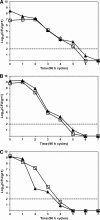Moderate temperature fluctuations rapidly reduce the viability of Ralstonia solanacearum race 3, biovar 2, in infected geranium, tomato, and potato plants
- PMID: 20851983
- PMCID: PMC2976264
- DOI: 10.1128/AEM.01580-10
Moderate temperature fluctuations rapidly reduce the viability of Ralstonia solanacearum race 3, biovar 2, in infected geranium, tomato, and potato plants
Abstract
Most Ralstonia solanacearum strains are tropical plant pathogens, but race 3, biovar 2 (R3bv2), strains can cause bacterial wilt in temperate zones or tropical highlands where other strains cannot. R3bv2 is a quarantine pathogen in North America and Europe because of its potential to damage the potato industry in cooler climates. However, R3bv2 will not become established if it cannot survive temperate winters. Previous experiments showed that in water at 4°C, R3bv2 does not survive as long as native U.S. strains, but R3bv2 remains viable longer than U.S. strains in potato tubers at 4°C. To further investigate the effects of temperature on this high-concern pathogen, we assessed the ability of R3bv2 and a native U.S. strain to survive typical temperate winter temperature cycles of 2 days at 5°C followed by 2 days at -10°C. We measured pathogen survival in infected tomato and geranium plants, in infected potato tubers, and in sterile water. The population sizes of both strains declined rapidly under these conditions in all three plant hosts and in sterile water, and no culturable R. solanacearum cells were detected after five to seven temperature cycles in plant tissue. The fluctuations played a critical role in loss of bacterial viability, since at a constant temperature of -20°C, both strains could survive in infected geranium tissue for at least 6 months. These results suggest that even when sheltered in infected plant tissue, R3bv2 is unlikely to survive the temperature fluctuations typical of a northern temperate winter.
Figures



Similar articles
-
Interactions with hosts at cool temperatures, not cold tolerance, explain the unique epidemiology of Ralstonia solanacearum race 3 biovar 2.Phytopathology. 2009 Oct;99(10):1127-34. doi: 10.1094/PHYTO-99-10-1127. Phytopathology. 2009. PMID: 19740025
-
Genotypic and Phenotypic Analyses Show Ralstonia solanacearum Cool Virulence Is a Quantitative Trait Not Restricted to "Race 3 Biovar 2".Phytopathology. 2024 Dec;114(12):2468-2480. doi: 10.1094/PHYTO-06-24-0187-R. Epub 2024 Dec 5. Phytopathology. 2024. PMID: 39186006
-
Genome Resource: Ralstonia solanacearum Phylotype II Sequevar 1 (Race 3 Biovar 2) Strain UW848 From the 2020 U.S. Geranium Introduction.Plant Dis. 2021 Jan;105(1):207-208. doi: 10.1094/PDIS-06-20-1269-A. Epub 2020 Nov 11. Plant Dis. 2021. PMID: 33175669
-
Comparative effect of low temperature on virulence and twitching motility of Ralstonia solanacearum strains present in Florida.Phytopathology. 2012 Feb;102(2):185-94. doi: 10.1094/PHYTO-05-11-0145. Phytopathology. 2012. PMID: 21936660
-
Ralstonia solanacearum, a widespread bacterial plant pathogen in the post-genomic era.Mol Plant Pathol. 2013 Sep;14(7):651-62. doi: 10.1111/mpp.12038. Epub 2013 May 30. Mol Plant Pathol. 2013. PMID: 23718203 Free PMC article. Review.
Cited by
-
Sustainable and Ecofriendly Approach of Managing Soil Born Bacterium Ralstonia solanacearum (Smith) Using Dried Powder of Conyza canadensis.Pathogens. 2020 Apr 27;9(5):327. doi: 10.3390/pathogens9050327. Pathogens. 2020. PMID: 32349319 Free PMC article.
-
Erwinia amylovora psychrotrophic adaptations: evidence of pathogenic potential and survival at temperate and low environmental temperatures.PeerJ. 2017 Oct 26;5:e3931. doi: 10.7717/peerj.3931. eCollection 2017. PeerJ. 2017. PMID: 29085749 Free PMC article.
-
Recent trends in control methods for bacterial wilt diseases caused by Ralstonia solanacearum.Microbes Environ. 2015;30(1):1-11. doi: 10.1264/jsme2.ME14144. Epub 2015 Mar 26. Microbes Environ. 2015. PMID: 25762345 Free PMC article. Review.
-
Ralstonia solanacearum Facing Spread-Determining Climatic Temperatures, Sustained Starvation, and Naturally Induced Resuscitation of Viable but Non-Culturable Cells in Environmental Water.Microorganisms. 2022 Dec 16;10(12):2503. doi: 10.3390/microorganisms10122503. Microorganisms. 2022. PMID: 36557756 Free PMC article.
-
Bioactive Secondary Metabolites from Trichoderma spp. against Phytopathogenic Bacteria and Root-Knot Nematode.Microorganisms. 2020 Mar 13;8(3):401. doi: 10.3390/microorganisms8030401. Microorganisms. 2020. PMID: 32182971 Free PMC article.
References
-
- Agrios, G. N. 2005. Plant Pathology, 5th ed. Elsevier Academic Press, Amsterdam, Netherlands.
-
- Allen, C., A. Kelman, and E. R. French. 2001. Brown rot of potatoes, p. 11-13. In W. R. Stevenson, R. Loria, G. D. Franc, and D. P. Weingartner (ed.), Compendium of potato diseases, 2nd ed. APS Press, St. Paul, MN.
-
- Alvarez, B., M. Lopez, and E. Biosca. 2008. Survival strategies and pathogenicity of Ralstonia solanacearum phylotype II subjected to prolonged starvation in environmental water microcosms. Microbiology 154:3590-3598. - PubMed
-
- Brown, D., and C. Allen. 2004. Ralstonia solanacearum genes induced during growth in tomato: an inside view of bacterial wilt. Mol. Microbiol. 53:1641-1660. - PubMed
Publication types
MeSH terms
LinkOut - more resources
Full Text Sources

